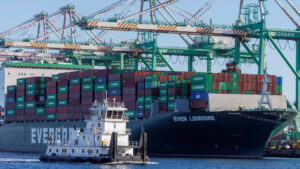The Impact of Tariffs on U.S. Trade: A Deep Dive
As we navigate the ever-shifting landscape of global trade, understanding the intricacies of our economy is more vital than ever. Recently, major shifts in shipping dynamics have highlighted the profound effects of tariffs on U.S. imports, especially from China. In this blog post, we’ll unpack the latest developments and what they mean for investors, businesses, and consumers alike.
The Plummeting Shipments from China
At the forefront of this discussion is the Port of Los Angeles, America’s busiest container port. Executive Director Gene Seroka recently revealed alarming projections: shipments from China are expected to plummet by over 35% next week compared to the same period last year. This decline comes on the heels of aggressive tariffs imposed by President Donald Trump, which have led many retailers to sharply reduce their import orders.
What’s Driving This Decline?
Seroka explained on CNBC’s "Squawk Box" that the latest data indicates a significant drop in cargo volume, particularly concerning given that approximately 45% of the port’s business derives from shipments coming in from China. Many retailers, feeling the pressure of increased tariffs, have halted import orders, anticipating potential supply chain disruptions.
In the face of these challenges, some transport companies are attempting to diversify their supply routes, seeking out goods from other Southeast Asian nations to fill their containers. However, as Seroka aptly pointed out, “realistically speaking, until some accord or framework can be reached with China, the volume coming out of there will be very light at best.”
Consequences for Retailers and Consumers
The immediate impacts of these disruptions are expected to reverberate through various sectors. Seroka forecasts that approximately 25% of ship arrivals at the port will be canceled in May, underlining the severity of the situation. U.S. Treasury Secretary Scott Bessent has labeled this trade climate as "unsustainable," yet businesses are hesitant to pivot swiftly without clear signs of resolution.
Economists, including Apollo Global Management’s Torsten Slok, alert us to the potentially dire consequences of these changes. The timeline suggests that as imports from China dwindle, layoffs in transportation and retail sectors could follow, leading to empty shelves and a possible recession.
Stockpiling: A Double-Edged Sword
Interestingly, Seroka noted that many retailers had preemptively stocked up on inventory ahead of the tariff announcements. This means that while an immediate shortage might not be apparent—shoppers may still find some options available—consumers could soon experience diminished variety and increased prices. For instance, you might locate that elusive blue shirt, but perhaps only alongside an overwhelming selection of purple alternatives, with rising costs reflecting the scarcity.
What Investors Need to Know
For our savvy investors at Extreme Investor Network, the insights gleaned from these developments are invaluable. The escalating trade tensions present both risks and opportunities. Here’s how you can navigate this landscape:
-
Diversify Investments: Consider exploring companies that have adapted quickly to supply chain disruptions. Those pivoting toward alternative manufacturing bases may perform better in the long run.
-
Monitor Retail Sector Closely: With the impact on inventories, retailers may face volatile stock prices. Assess companies based on their ability to adapt to changing market demands.
- Stay Informed: As negotiations between the U.S. and China remain stagnant, continue to monitor the news for potential breakthroughs or further escalations.
In conclusion, while the current landscape of trade appears challenging, there are avenues for resilience and opportunity. At Extreme Investor Network, we’re committed to keeping you informed and prepared for whatever economic shifts lie ahead. The ebb and flow of trade dynamics remind us that informed decisions rooted in current data can help us navigate through uncertainties and capitalize on emerging opportunities.

